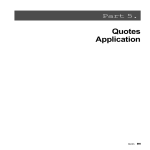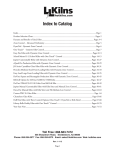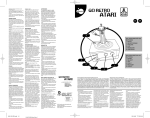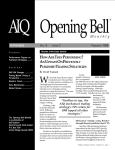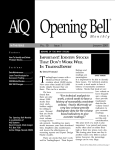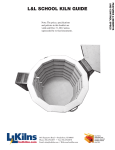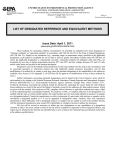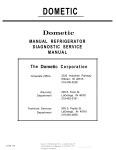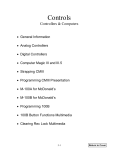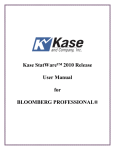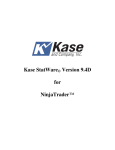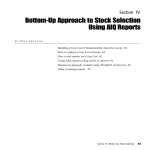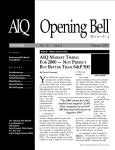Download November 1999
Transcript
AIQ Opening Bell Monthly IN THIS ISSUE Feature VOL. 8 ISSUE 11 N OVEMBER 1999 EXPERT DESIGN STUDIO AT WORK Expert Design Studio Short Selling Model ..................... 1 SHORT SELLING CANDLESTICK MODEL S ec t i o n s An Effective Screening Technique for Shorting Stocks S&P 500 Changes .............. 4 Tools of the Trade -- RSI Indicator .............................. 5 User Created Indicators ... 6 Market Review .................... 8 Data Maintenance ............. 8 The Opening Bell Monthly is a publication of AIQ Systems David Vomund, Chief Analyst P.O. Box 7530 Incline Village, Nevada 89452 By David Vomund F or most of the 1990s, it was very difficult making money by shorting stocks. Thats because the market increased with very few corrections. Over the last two years, however, the market has increased in value but there have been corrections that were large enough for short sellers to do well. and buy low. Short sales are DAVID VOMUND accomplished by borrowing stock for use in the initial trade, then repaying the loan in a later trade. Lets clarify this with an example. At the start of the day, Mr. Williams owns 100 shares of IBM which are being held in street name at AG Edwards. Later in the Even if you day, a Ms. are not an Hanna places aggressive short The worst rules for buying an order with seller, an stocks long can be the best rules her broker, AG occasional Edwards, to for selling stocks short...the short sale can sell 100 shares help diversify least effective rules for buying of IBM short and lower the stocks long involve two candle- (Mr. Williams risk of a portfostick chart patterns--the Hang- believes IBM lio that is long will move the market. In ing Man and the Harami. higher while this article, Ms. Hanna well develop believes IBM an effective screening technique for will fall.) In this case, AG Edwards shorting stocks. takes the 100 shares of IBM that they are When you buy a stock long you holding in street name for Mr. Williams are betting that the security will increase and sell them for Ms. Hanna to some in value. Hence the old adage buy low other investor, Mr. Jones. If Ms. Hanna and sell high. For short sales, the is right and the price of IBM falls, she saying might be reworded as sell high can buy her position back at a profit. Expert Design Studio continued on page 2 ® AIQ Opening Bell EXPERT DESIGN STUDIO AT WORK continued . . . Mr. Jones would have a paper loss since he is long the stock. Figure 1 What if IBM pays a cash dividend during the short sales? IBM sends the dividend to Mr. Jones, the holder of the securities. However, since Mr. Williams still owns the IBM stock, he also expects a dividend check. In this case, the short seller, Ms. Hanna, pays the dividend amount to AG Edwards who in turn sends a dividend check to Mr. Williams. There are risks to short selling. Stocks that are bought long cannot drop below zero and, therefore, do not involve a loss greater than the total investment. But a stock sold short could, theoretically, produce an unlimited loss since there is no ceiling on a stocks appreciation potential. Those who shorted Qualcomm or Nextel can appreciate this fact! Since a short sale involves a loan, there is a risk to the brokerage firm that the loan will not be repaid. To protect the broker, the short seller does not have access to the money received from the initial sale of securities and a margin requirement must be met. In developing our short-selling model, we are using the research that appeared in the June 1999 Opening Bell. In that issue, we tested all the pre-built Expert Design Studio screening rules that come with TradingExpert Pro and ranked them from best to worst based on their effectiveness. All the rules were tested for long trades. The worst rules for buying stocks long can be the best rules for selling stocks short. Our testing found the least effective rules for buying stocks long involve two candlestick chart patternsthe Hanging Man and the Harami. We will use the Harami candlestick pattern in our model. With a candlestick chart the real body is the difference between the opening price and closing price. For the Harami pattern, a small real body follows a long real body. This pattern is somewhat comparable to an inside day pattern in bar charts. Figure 2 PLEASE SEND CORRESPONDENCE TO: Opening Bell Monthly G.R. Barbor, Editor P.O. Box 7530 Incline Village, NV 89452 AIQ Opening Bell Monthly does not intend to make trading recommendations, nor do we publish, keep or claim any track records. It is designed as a serious tool to aid investors in their trading decisions through the use of AIQ software and an increased familiarity with technical indicators and trading strategies. AIQ reserves the right to use or edit submissions. For subscription information, phone 1-800-332-2999 or 1-775-831-2999. © 1992-1999, AIQ Systems 2 NOVEMBER 1999 AIQ Opening Bell EXPERT DESIGN STUDIO AT WORK continued . . . An example of a Harami candlestick pattern appears in Figure 1. On October 4, IBMs real body (rectangular box on the candlestick chart) is engulfed by the previous days real body. Another Harami is found on September 20. Figure 3 The Harami pattern is thought to be a reversal pattern. A stock in an uptrend that forms a Harami pattern is susceptible to a downward move. Conversely, a stock in a downtrend that forms a Harami often moves higher. Our testing using the Expert Design Studio package, however, shows that the trend is fairly insignificant and that stocks with Harami candlesticks typically underperform the market whether they are in an uptrend or a downtrend. TradingExpert Pros Expert Design Studio module provides prebuilt rules that can be used to search for many different candlestick patterns. Since candlestick formations are open to interpretation, some candlestick enthusiasts may disagree with how we created the rules. For example, when a textbook says a candlestick has a large real body followed by a small real body, what exactly is large and what is small? For our model, we used AIQs prebuilt Harami rule without change. To open the pre-built Harami rule, go to the Expert Design Studio module and select File then Open. Double-click the EDS Strategies folder, then doubleclick the Basic Indicator Strategies folder, next double-click the Candlestick folder, and finally open the Figure 4 Harami file. In Figure 2 we test the Harami pre-built screening rule on a database consisting of the S&P 500 stocks using a sell strategy of 85% principal protect, and a 95% profit protect above 15%. We tested the model on the long side. We see that after a Harami candlestick pattern, stocks greatly underperform the market. The average stock increased 1.14% in the 70 days after a Harami pattern. An equivalent trade in the S&P 500 gained 3.46%. Hence, a bad rule for buying stocks long can be a good rule for selling stocks short. The second and final rule in our short-selling model uses the RSI AIQ indicator. Contrary to what youd believe, a buy signal on the RSI AIQ indicator is bearish. The pre-built rule that says the RSI AIQ must rise from below 30 to above 30 was one of the worst rules for buying a stock long. Saying that an RSI AIQ buy signal is bearish may sound controversial. Yet, short sellers often short downtrending stocks after a shortterm rally. These are equivalent patterns. The RSI AIQ indicator is Expert Design Studio continued on page 4 NOVEMBER 1999 3 AIQ Opening Bell EXPERT DESIGN STUDIO AT WORK continued . . . fairly insensitive so it takes a lot of downside movement for it to move to oversold territory (a value below 30). When a weak stock advances, it can give an RSI AIQ buy signal. Figure 5 Figure 3 displays a backtest of the AIQ RSI buy signals using the same criteria that was used for Figure 2. Again, the test was for buying stocks long. We see that buying weak stocks after a short advance is a losing strategy. In the 70 days after an AIQ RSI buy signal, the average S&P 500 stock only advanced 0.10% whereas the S&P 500 gained 3.41%. Our final short-selling screening model combines the Harami and RSI AIQ rules. That is, the model looks for stocks that have a Harami pattern and have given an AIQ RSI buy signal anytime in the last two days. A backtest of the final model is found in Figure 4. Since this model was designed for screening short selling candidates, we tested the model on the short side. As before, we used 85% principal protect, and 95% profit protect above 15%. We see the average short trade made 0.87% per trade. If you shorted the S&P 500 index you would have lost an average of 3.17% per trade. This model actually shows a profit by shorting stocks over the last two years. An example of a stock that fits our model is Novell Inc. on October 5. Figure 5 shows that it formed a Harami pattern as its real body was contained within the previous days real body. At the same time that the Harami was formed, the RSI AIQ indicator gave a buy signal. This indicator moved from below to above the lower horizontal line. This short-selling technique has worked well in the type of market that weve seen over the last few years. Well continue to monitor its performance. Our confidence in the model will increase the longer it works. AIQ users can download the models file from AIQs web page at www.aiq.com. Click on educational products and then select Opening Bell newsletter. In the lower right corner, select the file that corresponds to the November Opening Bell. n David Vomund publishes VIS Alert, a weekly investment newsletter. For a sample copy go to www.visalert.com or call (775) 831-1544. About Expert Design Studio... AIQs Expert Design Studio (EDS) was developed for users who want to create and test their own customized screening reports or mechanical trading systems. For those unfamiliar with Expert Design 4 Studio, an introductory tutorial is included in AIQs New User Guide. Full documentation can be found in the TradingExpert Pro User Manual (Part 2, page 393). S&P 500 Changes Analog Devices (ADI) replaces Ameritech (AIT). ADI is added to the Electronics-Semiconductors (ELECTRONS) group. T. Rowe Price Associates (TROW) replaces Data General (DGN). TROW is added to the Investment Management (INVESTMG) group. Leggett & Platt (LEG) replaces Cyprus Amax Minerals (CYM). LEG is added to the Household Furnishings & Appliances (HOUSEFUR) group. El Paso Energy (EPG) replaces Sonat Inc. (SNT). EPG is added to the Natural Gas (NATURALG) group. Comverse Technology (CMVT) replaces ASARCO Inc. (AR). CMVT is added to the Communications Equipment (COMMUNEQ) group. Harcourt General (H) will move from Retail-Department Stores (RETAILDE) to Publishing (PUBLISHI) group. NOVEMBER 1999 AIQ Opening Bell TOOLS OF THE TRADE THE RSI INDICATOR TRADINGEXPERT'S TWO APPROACHES EXPLAINED N Figure 6 ew users of TradingExpert Pro may find it a bit confusing that AIQ has two versions of the well known Relative Strength Index (RSI) indicator, developed by Welles Wilder. Before discussing the differences, well first give some background on the indicator. New technicians often assume the RSI indicator is a type of Relative Strength indicator. That is a bit of a misnomer in that the indicator has nothing to do with Relative Strength, which measures the performance of a security relative to other securities. Instead, the RSI indicator is an overbought/oversold indicator and the only data needed for its calculation is the closing price of the security under study. At the time of the development of the RSI, most people looked at todays price of a security divided by the price x days ago to measure momentum. Mr. Wilder saw two problems with this calculation. First, this type of indictor can become erratic simply because of the numbers that are being dropped off. Second, this type of indicator can go up for quite some time without giving a clue as to what is really a high value. A constant range of values was needed for comparison purposes. RSI solves these problems by smoothing its values and normalizing all values to a range of between 0 and 100. The actual formula is calculated as follows: RSI=100 [100/(1+RS)] where RS = Average of x days closing prices on up days divided by the average of x days closing prices on down days. With this formula in mind, the difference between the RSI Wilder NOVEMBER 1999 indicator and the RSI AIQ indicator is how the averages for the up and down days are calculated. In AIQs calculation, exponential moving averages are used whereas Wilders version uses simple moving averages. It sounds like a small difference, but an examination of the resulting indicators can yield significant variations. Wilders RSI is much more volatile than AIQs RSI. To partially offset this, the default value for the moving average time period was lowered from 14 (which is the number of days Wilder originally used) to 7 for the AIQ version of RSI. Figure 6 shows the Dow with both versions of the RSI. The most simple interpretation of the RSI is: when its value moves above the 70 level the security is considered overbought and due for a correction. A sell is registered when the indicator falls from above 70 to below 70. When the RSI value falls below 30, the security is oversold and will likely rally. A buy is registered when the indicator rises from below 30 to above 30. Examining Figure 6, we see the two indicators tend to move together but they reach overbought and oversold levels at different times. Both RSI indictors work beautifully on nontrending securities. When a security is in the upper end of its trading range, RSI is often above 70 and ready to give a sell. When a security is near the lower end of its trading range, RSI is often below 30 and ready to give a buy. Using the buy and sell signals in their simplest form, the RSI indicators are not effective for trending securities. For an uptrending security, the RSI will give sell signals as the stock moves higher. When the overall market is in an uptrend, few stocks will give RSI buy signals and those that do are market laggards. n 5 AIQ Opening Bell USER CREATED INDICATORS WANT TO ADD NEW INDICATORS TO YOUR TRADINGEXPERT PROGRAM? HERES HOW By David Vomund Figure 7 A t AIQs fall seminar, technical analyst John Murphy gave an outstanding presentation on indicator analysis and sector rotation. One of the indicators that he used was calculated as the difference between a 10-week moving average and a 40-week moving average. This is not one of the standard indicators in TradingExpert. Fortunately, TradingExpert provides users with the ability to create indicators using the Expert Design Studio module. To create an indicator, we first need to create a User Defined Function (UDF) in Expert Design Studio. To create a User Defined Function, do the following: Enter the Expert Design Studio and select File from the menu bar, then New. To create a rule that calculates the difference between two moving averages, type at the cursor: MADif is [ST MA] - [IT MA]. Save the file by selecting File from Figure 8 the menu and then click Save. Well call the file MA Dif. Note: For more information on User Defined Functions, see page 439 in the User Manual. To create an indicator, use the following procedure: Enter the Charts application. Select Chart from the menu bar and click Settings, Indicator Library, and EDS Indicators. The Custom Indicators screen that appears lists the EDS indicators that have been previously created. Click Add to create a new EDS indicator (Figure 7). In the Open dialog box, open the MA Dif.eds file. In the Plot Type dialog box, select Histogram and click Next. The Histogram Indicator dialog box will appear. In the box labeled Description, type a name for the new 6 NOVEMBER 1999 AIQ Opening Bell USER CREATED INDICATORS continued . . . indicator. From the UDF to Plot text box, select MADif (Figure 8). Click Finish. Figure 9 When the Custom Indicators dialog box reappears, click Done. The newly created indicator will now appear as one of the choices in the control panel of the AIQ charts. Figure 9 plots the Semiconductor Index (SOX) along with its 10-week and 40-week moving averages. Our newly created indicator, MA Dif, which looks at the difference between two moving averages is plotted. Whenever the moving averages cross each other (see arrows) our MA Dif indicator crosses the zero line. John Murphy points out that the MA Dif indicator gives you the advantage of looking for divergences. For example, the SOX hit a new low in the summer of 1996 but the MA Dif indicator was moving higher. The same thing happened last fall. A negative divergence appeared this summer when the SOX rallied to new highs but the MA Dif only matched its previous high. Other simple indicators can be created. For example, people have expressed an interest in plotting the ADX indicator without the ADXR line. This is easily accomplished using the following EDS code: ADX is [ADX]. Another request is the ability to plot a moving average of an indicator. For example, the Money Flow indicator is a simple line. By creating a UDF Figure 10 we can create a Money Flow indicator and plot a moving average of the indicator. The following EDS code is used to plot a 50-day moving average of Money Flow: MF is [MnyFlow]. Avg is SimpleAvg([MnyFlow],50). When creating this indicator using the above procedure, select Two Lines in the Plot Type dialog box. The UDF called MF will plot the Money Flow indicator and the UDF called Avg will plot the moving average of Money Flow. Figure 10 shows Andrew Corp. with a 50-day moving average of Money Flow. Plotting a moving average on Money Flow can help identify trend changes. Also shown in Figure 8 is the ADX indicator without the ADXR line. User created indicators can not be tested within the Expert Design Studio application. For more detailed information on user created indicators, see page 484 in the User Manual. n NOVEMBER 1999 7 AIQ Opening Bell MARKET REVIEW I t seems too easy but a simple market timing strategy of exiting the market in the summer and reentering during an October selloff has once again proven to be a good strategy. Those that see the month of October as a glass half full recognize that good buying opportunities often occur during the month. Unlike last year, this Octobers low point will not likely lead to a strong rally. Thats because the selloff was much more mild than it was last year. Investors in large-cap Nasdaq or technology stocks wouldnt even have known there was a correction. The Nasdaq Composite barely moved lower and closed at a new high at the end of the month. We often focus on daily chart analysis but we can turn to weekly charts for a longer-term perspective. In October, the weekly Stochastic indicator moved into oversold territory (Figure 11). During the bull run in the 90s, these signals have proven to be effective (see arrows). From its July high to its October low, the S&P 500 corrected 12%. October was an active month for the AIQ market timing model and we had some whipsaw signals. Heading into October, the AIQ timing model was on a September 27 buy signal. An additional 100 buy signal was registered on October 4. The model switched to a sell mode on October 12 when it registered a 100 sell signal. This signal was confirmed on that day as the Phase indicator was decreasing. The sell signal only lasted two days when a 99 buy signal was registered on October 14. This signal was not confirmed until October 20 when the Phase indicator increased in value. An additional 95 buy signal came on October 22. Finally, a 96 sell signal was registered on October 25. This signal came just before the market staged an impressive rally. This is a case where confirmation helped weed out a bad signal. By months end, the Figure 11 signal was still unconfirmed. For the month, the best performing group is Software & Processing. The AIQ Pyramid software group contains high flying stocks such as Adobe Systems, I2 Technologies, and Veritas Software. Overall, the financial groups were the biggest winners, gaining about 15%. The worst groups were unchanged on the month and include Pollution Waste Management, Casinos, Heavy Machinery, Chemicals-Commodity, and Aluminum. n STOCK DATA MAINTENANCE The following table shows past and future stock splits and large dividends: Stock Genentech Sapient Corp. Jakks Pacific King Pharmaceuticals Phone.com Trinitech Sys. Ticker Split/Div. Approx. Date GNE SAPE JAKK KING PHCM TSI Name/Ticker Changes: British Stell PLC (BST) Foodmaker Inc. (FM) Hadco Corp (HDCO) WestPoint Stevens Inc. (WPSN) to to to to 2:1 2:1 3:2 3:2 2:1 3:2 11/03/99 11/08/99 11/11/99 11/12/99 11/15/99 11/16/99 Stock 1st Commonwealth Fin. Timberline Software Veritas Software Amgen ChoicePoint Advance Paradign Ticker Split/Div. Approx. Date FCF TMBS VRTS AMGN CPS ADVP 2:1 4:3 3:2 2:1 2:1 2:1 11/19/99 11/22/99 11/22/99 11/22/99 11/25/99 12/01/99 Corus Group PLC (CGA) Jack in the Box (JBX) Hadco Corp (HDC) WestPoint Stevens Inc. (WXS) Trading Suspended: Ameritech Corp. (AIT), Bank Boston Corp. (BKB), Capital RE Corp. (KRE), Centocor Inc. (CNTO), Data General (DGN), Everen Capital Corp. (EVR), Frontier Corp. (FRO), Lone Star Industries (LCE), Marshall Industries (MI), Pioneer Hi-Bred (PHB), Sbarro Inc. (SBA), Smithfield Foods Inc. (SFDS), St. Paul Bancorp (SPBC), Unitrode Corp (UTR) 8 NOVEMBER 1999








